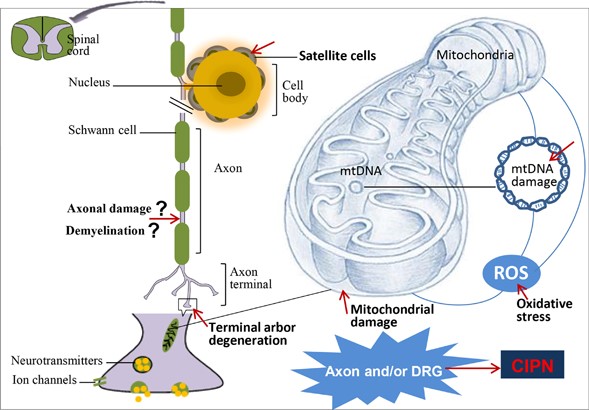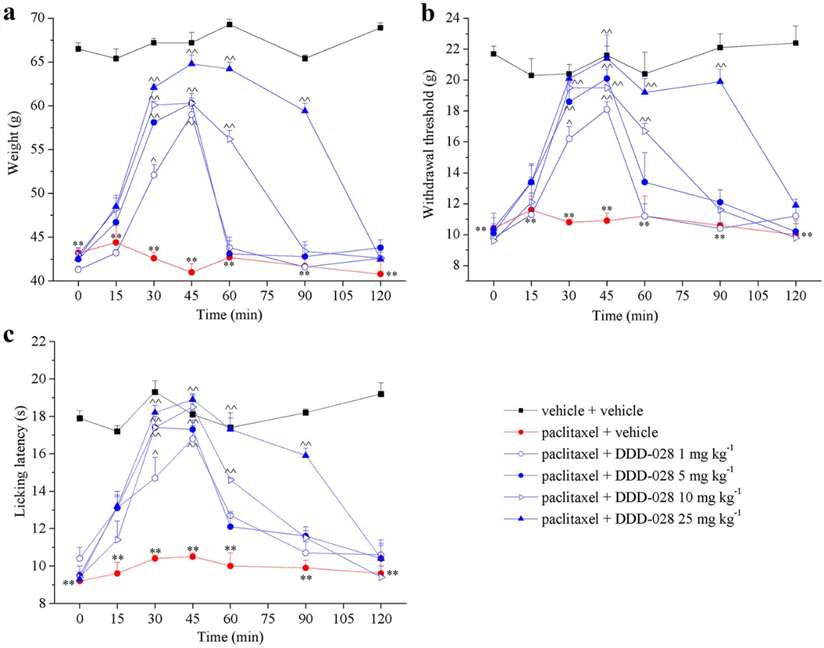- You are here: Home
- Services
- Disease Models
- Pain Models
- Neuropathic Pain Models
- Chemotherapy-Induced Neuropathic Pain (CIPN) Model
Services
-
Cell Services
- Cell Line Authentication
- Cell Surface Marker Validation Service
-
Cell Line Testing and Assays
- Toxicology Assay
- Drug-Resistant Cell Models
- Cell Viability Assays
- Cell Proliferation Assays
- Cell Migration Assays
- Soft Agar Colony Formation Assay Service
- SRB Assay
- Cell Apoptosis Assays
- Cell Cycle Assays
- Cell Angiogenesis Assays
- DNA/RNA Extraction
- Custom Cell & Tissue Lysate Service
- Cellular Phosphorylation Assays
- Stability Testing
- Sterility Testing
- Endotoxin Detection and Removal
- Phagocytosis Assays
- Cell-Based Screening and Profiling Services
- 3D-Based Services
- Custom Cell Services
- Cell-based LNP Evaluation
-
Stem Cell Research
- iPSC Generation
- iPSC Characterization
-
iPSC Differentiation
- Neural Stem Cells Differentiation Service from iPSC
- Astrocyte Differentiation Service from iPSC
- Retinal Pigment Epithelium (RPE) Differentiation Service from iPSC
- Cardiomyocyte Differentiation Service from iPSC
- T Cell, NK Cell Differentiation Service from iPSC
- Hepatocyte Differentiation Service from iPSC
- Beta Cell Differentiation Service from iPSC
- Brain Organoid Differentiation Service from iPSC
- Cardiac Organoid Differentiation Service from iPSC
- Kidney Organoid Differentiation Service from iPSC
- GABAnergic Neuron Differentiation Service from iPSC
- Undifferentiated iPSC Detection
- iPSC Gene Editing
- iPSC Expanding Service
- MSC Services
- Stem Cell Assay Development and Screening
- Cell Immortalization
-
ISH/FISH Services
- In Situ Hybridization (ISH) & RNAscope Service
- Fluorescent In Situ Hybridization
- FISH Probe Design, Synthesis and Testing Service
-
FISH Applications
- Multicolor FISH (M-FISH) Analysis
- Chromosome Analysis of ES and iPS Cells
- RNA FISH in Plant Service
- Mouse Model and PDX Analysis (FISH)
- Cell Transplantation Analysis (FISH)
- In Situ Detection of CAR-T Cells & Oncolytic Viruses
- CAR-T/CAR-NK Target Assessment Service (ISH)
- ImmunoFISH Analysis (FISH+IHC)
- Splice Variant Analysis (FISH)
- Telomere Length Analysis (Q-FISH)
- Telomere Length Analysis (qPCR assay)
- FISH Analysis of Microorganisms
- Neoplasms FISH Analysis
- CARD-FISH for Environmental Microorganisms (FISH)
- FISH Quality Control Services
- QuantiGene Plex Assay
- Circulating Tumor Cell (CTC) FISH
- mtRNA Analysis (FISH)
- In Situ Detection of Chemokines/Cytokines
- In Situ Detection of Virus
- Transgene Mapping (FISH)
- Transgene Mapping (Locus Amplification & Sequencing)
- Stable Cell Line Genetic Stability Testing
- Genetic Stability Testing (Locus Amplification & Sequencing + ddPCR)
- Clonality Analysis Service (FISH)
- Karyotyping (G-banded) Service
- Animal Chromosome Analysis (G-banded) Service
- I-FISH Service
- AAV Biodistribution Analysis (RNA ISH)
- Molecular Karyotyping (aCGH)
- Droplet Digital PCR (ddPCR) Service
- Digital ISH Image Quantification and Statistical Analysis
- SCE (Sister Chromatid Exchange) Analysis
- Biosample Services
- Histology Services
- Exosome Research Services
- In Vitro DMPK Services
-
In Vivo DMPK Services
- Pharmacokinetic and Toxicokinetic
- PK/PD Biomarker Analysis
- Bioavailability and Bioequivalence
- Bioanalytical Package
- Metabolite Profiling and Identification
- In Vivo Toxicity Study
- Mass Balance, Excretion and Expired Air Collection
- Administration Routes and Biofluid Sampling
- Quantitative Tissue Distribution
- Target Tissue Exposure
- In Vivo Blood-Brain-Barrier Assay
- Drug Toxicity Services
Chemotherapy-Induced Neuropathic Pain (CIPN) Model
Creative Bioarray offers a chemotherapy-induced neuropathic pain model utilizing paclitaxel, designed to facilitate the evaluation and validation of the efficacy of analgesic drugs in preclinical research. This model is meticulously developed to mimic the neuropathic pain experienced by cancer patients undergoing chemotherapy, providing a crucial platform for understanding the mechanisms underlying chemotherapy-induced peripheral neuropathy (CIPN) and for testing potential therapeutic interventions.
CIPN represents a significant and debilitating side effect associated with numerous efficacious cancer chemotherapeutic agents, known to impair daily functioning and diminish quality of life. In cases where pain is particularly severe, patients may necessitate a switch to less efficacious chemotherapy agents or may opt to discontinue treatment altogether. A variety of commonly employed chemotherapeutic agents, including platinum derivatives, taxanes, vinca alkaloids, epothilones, and newer agents such as thalidomide and bortezomib, have been documented to induce neurotoxic effects.
The neurotoxic impact of cancer chemotherapy agents on the peripheral nervous system (PNS) is multifaceted, affecting axons and cell bodies of dorsal root ganglion (DRG) neurons, leading to axonal damage characterized by intraepidermal nerve fiber (IENF) loss and terminal arbor degeneration, mitochondrial damage, and oxidative stress, potentially linked to inflammatory processes. Pathological changes in DRG neurons and their adjacent satellite cells include alterations in the expression levels of various ion channels, neurotransmitters, and their receptors, alongside changes in gene expression. Mitochondrial dysfunction and IENF loss emerge as pivotal pathobiological features of CIPN, directly correlated with pain behaviors in rodent models.
 Fig. 1 CIPN pathogenesis and associated morphologic changes. (Han et al. 2013)
Fig. 1 CIPN pathogenesis and associated morphologic changes. (Han et al. 2013)
Our Chemotherapy-Induced Neuropathic Pain (CIPN) Model
- Available Animal
Rat
- Modeling Method
Paclitaxel is administrated to each animal by repeated injections to induce neuropathic pain.
- Endpoints
- Clinical observation
- Body weight
- Behavioral tests: Von Frey test, Hot plate test, etc.
- qPCR or Western blot
- Histology analysis
- Other customized endpoints
Example Data
 Fig. 2 Effect of single DDD-028 administrations on pain behavior induced by paclitaxel. Sensitivity to a noxious mechanical stimulus as measured by the paw pressure test (a). Pain threshold to a non-noxious mechanical stimulus as measured by the von Frey test (b). Pain threshold to a non-noxious thermal stimulus as measured by the cold plate test (c). Paclitaxel (2.0 mg kg−1, i.p.) was administered on four days (1, 3, 5, and 8). (Micheli et al. 2021)
Fig. 2 Effect of single DDD-028 administrations on pain behavior induced by paclitaxel. Sensitivity to a noxious mechanical stimulus as measured by the paw pressure test (a). Pain threshold to a non-noxious mechanical stimulus as measured by the von Frey test (b). Pain threshold to a non-noxious thermal stimulus as measured by the cold plate test (c). Paclitaxel (2.0 mg kg−1, i.p.) was administered on four days (1, 3, 5, and 8). (Micheli et al. 2021)
Meanwhile, we also provide other neuropathic pain models that maybe you are interested in:
- Diabetes-Induced Neuropathic Pain Model
- Chronic Constriction Injury (CCI) Model
- Spared Nerve Injury (SNI) Model
- Partial Sciatic Nerve Ligation (PSL/PSNL) Model
- Spinal Nerve Ligation (SNL) Model
Quotation and Ordering
At Creative Bioarray, we are devoted to the continuous development and refinement of a wide array of disease models, tailored to meet the evolving needs of our clients in the biomedical research community. If you are interested in our services, please feel free to contact us at any time or submit an inquiry to us directly. We look forward to cooperating with you.
References
- Micheli, L., et al. Pain relieving and neuroprotective effects of non-opioid compound, DDD-028, in the rat model of paclitaxel-induced neuropathy. Neurotherapeutics, 2021, 18: 2008-2020.
- Currie, G.L., et al. Animal models of chemotherapy-induced peripheral neuropathy: A machine-assisted systematic review and meta-analysis. PLoS biology, 2019, 17(5): e3000243.
- Han, Y., Smith, M.T. Pathobiology of cancer chemotherapy-induced peripheral neuropathy (CIPN). Frontiers in pharmacology, 2013, 4: 71202.
Explore Other Options
For research use only. Not for any other purpose.

